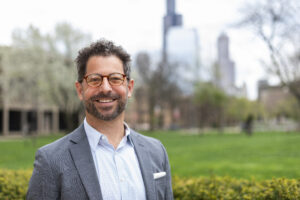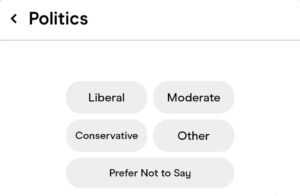By Ed Finkel of LISC’ Chicago’s New Communities Program

The power of creativity struck Chicago artist Monika Kimrey perhaps as never before recently when she worked with a severely developmentally disabled woman, named Arlene, who never spoke and made little eye contact.
During weekly sessions at South Chicago Parents and Friends, which provides a full range of services for the disabled including job training and placement, Kimrey noticed Arlene repeatedly painting, in calligraphic style, an angular shape that resembled the letter “A.”
Kimrey, who visits participants in the life skills training center once per week, pointed out the resemblance and told her it was the first letter of her name. “A,” Arlene responded, the first word anyone remembered her speaking, and continued to make the shape.
Once she had filled several sheets of paper with her calligraphic creations, Arlene became riveted as Kimrey bound them with needlepoint stitching and then told Arlene that she had created a book.
“She went over to the shelf, and she handed me a book,” Kimrey recalls. “This is where someone’s level of understanding really came out through the arts — the look on her face, the engagement. It was very clear she wanted to make another book. This is someone on a low-functioning level.”
Grants from LISC/NCP and MB Financial have led to the creation of this arts program, which Tom Schell, executive director of South Chicago Parents and Friends, says arose out of satisfaction surveys of residents and their families.
“We’re trying to take a look at what services are already in the community and not duplicate them,” he says. “Our hope is to eventually be able to showcase their work. … Our whole focus is on integration into the community.”
Kimrey has been traveling for just three months to South Chicago Parents and Friends, but she’s run a similar program at a Near South Side agency called CARC for about eight years, where some of her artist clients make several thousand dollars per year for their craftwork and/or through gallery placements.
“Working to bring revenue and focus into the community of people with disabilities is what I do,” Kimrey says. “I pull heavily on the Montessori model, allowing participants to be self-directed. I don’t do projects with the group on the whole. I try to expose clients to a wide variety of materials and observe them and their interests, depending on the functional level of the client.”
Jackie Samuel, NCP director at Claretian Associates in South Chicago, knew Kimrey and convinced her to visit the facility. Despite skepticism about how she would fit the visits into her already hectic schedule, Kimrey could not resist.

“Within two weeks of going there, I was like, ‘What a delight!’ ” Kimrey says. “The clients look forward to it. I look forward to it. I’m looking forward to those first coins falling into people’s pockets. … I’d like to see them working independently at the work site, much like a private contractor, working at their own pace, making a product they can sell, and keep the money.”
Samuel worked with Kimrey in the past as part of a citywide program called Puppetropolis, where she guided both preschoolers, as well as seniors who had dementia, in creating puppets.
“I was just in awe of how she was able to work with two so opposite groups of people and bring them together,” Samuel says. “She just treats people like people. She doesn’t realize she has a real gift and talent of patience. It’s a skill. She just works magic …
“It’s too bad we don’t have more people like Monika, who can see the beauty in all people, and it doesn’t matter what their abilities are,” she adds. “She sees the beauty in them, and she knows how to treasure them.”
The artwork helps participants at South Chicago Parents and Friends to develop fine and gross motor skills — and, as with Arlene, to develop their enthusiasm, as well. “They’re bringing things up front to us and saying, ‘Look what I’ve done,’ ” Schell says. “Like any of us, if it’s something they really like, they’re going to blossom.”
“Everywhere I go, I come into a new community, and I feel like I don’t have glasses on,” Kimrey says. “As I work with the methods I’ve used for years, people come into focus. They have skills, and it starts to become clear they have consciousness, and they have goals and desires.”
Cathy Clark-Haase, manager of advancement for the facility, which serves 245 people, echoes Samuel’s words in saying that Kimrey does not treat participants as if they have a disability. “They’ll ask, ‘Is Monika coming?’ ” Clark-Haase says. “It’s a sign they’re pleased.”
“Monika speaks with the individuals as artists,” Schell adds. “It’s not a teacher-student relationship. What we’ve always tried to stress is that everyone is equal here.”

In the short term, Kimrey hopes agency staff will come to anecdotal realizations about clients: “I bet you didn’t think this person could do this.” In the long run, she aims to educate those in the field in new ways to engage clients.
“They really are not fostering the amount of independence and personal choice that they could be,” she says, talking about those who work with the developmentally disabled in general. “I want to stop the sequestered aspect, how people in this community are kind of warehoused and hidden.”
Schell stresses that participants in the program can choose to seek services anywhere, which means agencies like South Chicago Parents and Friends must remain responsive. “[State] money is tied to the person,” he says. “Now, more than ever, our services have to meet their needs. We need to think of them as consumers.”
Although cuts in the recently passed state budget have impacted three of the agency’s grants, the developmental training program at South Chicago Parents and Friends has continued apace, Schell adds.
The agency also thinks of participants as potential producers; they construct everything from handmade toys to embroidery. At the long-time CARC program, quilts have been the largest product line, Kimrey says.
“For whatever reason, the textiles seem to be an area that consistently sparks this particular community’s interests,” she says. “Another group [from CARC] is exhibiting at galleries and shows, some bringing in $200 to $300.”
After giving her artists a chance to find their niche, Kimrey begins to provide some direction. “I start out very general, free form, and then strategically add a little more detail, a little more of a request,” she says. “Can you do it in this color? Can you follow this line, if I draw it for you? And finally: What project do you want to do? Can they be an architect of something – make that leap?”
In addition to the developmentally disabled, Kimrey would like to work with the refugee population as well as the formerly incarcerated.
“Populations that don’t have easy access to employment,” she says, “there’s definitely room for people to make a success of themselves. So many people can’t get employed, period. Even if it’s very part time, they can put it on their resume: ‘I’ve worked.’ It’s like, ‘Hey, welcome to the human race!’ ”

![Reblog this post [with Zemanta]](http://img.zemanta.com/reblog_e.png?x-id=61072061-ad02-448a-bed8-77d360723873)





Be First to Comment